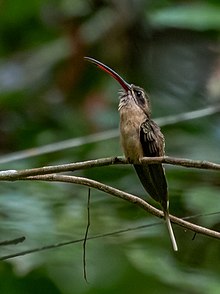Great-billed hermit
| Great-billed hermit | |
|---|---|

| |
| Scientific classification | |
| Domain: | Eukaryota |
| Kingdom: | Animalia |
| Phylum: | Chordata |
| Class: | Aves |
| Clade: | Strisores |
| Order: | Apodiformes |
| Family: | Trochilidae |
| Genus: | Phaethornis |
| Species: | P. malaris
|
| Binomial name | |
| Phaethornis malaris (Nordmann, 1835)
| |

| |
The great-billed hermit (Phaethornis malaris) is a species of
Taxonomy and systematics
The great-billed hermit's taxonomy is confusing. What are now the
These six subspecies of great-billed hermit are generally recognized:[3][8][9]
- P. m. malaris Nordmann (1835)
- P. m. insolitus Zimmer (1950)
- P. m. moorei Lawrence (1858)
- P. m. ochraceiventris Hellmayr (1907)
- P. m. bolivianus Gould (1861)
- P. m. margarettae Ruschi (1972)
The subspecies P. m. margarettae is sometimes treated as a separate species, "Margaretta's hermit" (P. margarettae), and P. m. ochraceiventris has also been considered for species rank. At least two other populations within the existing subspecies have been suggested as additional subspecies.[5][7]
Description
The great-billed hermit is 13 to 17.5 cm (5.1 to 6.9 in) long. Males weigh 4.5 to 10 g (0.16 to 0.35 oz) and females 4 to 8 g (0.14 to 0.28 oz). The nominate subspecies is the largest. It has greenish-brown upperparts and brownish to grayish underparts. Its uppertail coverts have dark and light ochre bands and the central tail feathers are long with long white tips. It has a long decurved bill, with the female's being shorter but more curved than the male's. P. m. insolitus is smaller than the nominate but otherwise similar. P. m. moorei has paler, grayer, underparts than the nominate. P. m. bolivianus and P. m. margarettae are the smallest subspecies. The former has a dark brown throat and breast and an orange-ochre belly; P. m. margarettae is very similar to bolivianus but has paler underparts. P. m. ochraceiventris has a bright orange breast and belly.[7]
Distribution and habitat
The subspecies of great-billed hermit are found thus:[3][7]
- P. m. malaris, Suriname, French Guiana, and north central Brazil's Amapá state
- P. m. insolitus, eastern Colombia, southern Venezuela, and the northwestern part of Brazil's Amazonas state
- P. m. moorei, eastern and southern Colombia through eastern Ecuador into northeastern Peru as far as the Marañón River
- P. m. ochraceiventris, northeastern Peru south of the Marañón River east into western Brazil south of the Amazon River as far as the Madeira River
- P. m. bolivianus, southeastern Peru to central Bolivia and into western Brazil between the Madeira and Tapajós rivers
- P. m. margarettae, coastal eastern Brazil from Pernambuco south to Espírito Santo
The subspecies inhabit the understory of a variety of
Behavior
Feeding
The great-billed hermit is a "trap-line" feeder like other hermit hummingbirds, visiting a circuit of a variety of flowering plants for nectar. Examples include Heliconia and Pitcairnia. It also consumes small arthropods.[7]
Breeding
The great-billed hermit's breeding seasons vary across its range, for instance at least August to December in French Guiana, June to September in Bolivia, and June to November in Peru. Like most hermits, it builds a cone-shaped nest of plant fibers and spider silk suspended from the underside of a drooping leaf. The clutch size is two eggs.[7]
Vocalization
The great-billed hermit's song is generally "a continuous series of single, bisyllablic rising, falling 'slee-up' notes" that differs somewhat among the subspecies. It also makes "a sharp 'skweep!'" call, usually in flight.[7]
Status
The
References
- ^ . Retrieved 11 December 2021.
- ^ "Appendices | CITES". cites.org. Retrieved 2022-01-14.
- ^ a b c Gill, F.; Donsker, D.; Rasmussen, P. (July 2021). "IOC World Bird List (v 11.2)". Retrieved July 14, 2021.
- ^ Remsen, J. V., Jr., J. I. Areta, E. Bonaccorso, S. Claramunt, A. Jaramillo, D. F. Lane, J. F. Pacheco, M. B. Robbins, F. G. Stiles, and K. J. Zimmer. Version 24 August 2021. Species Lists of Birds for South American Countries and Territories. https://www.museum.lsu.edu/~Remsen/SACCCountryLists.htm retrieved August 24, 2021
- ^ a b Remsen, J. V., Jr., J. I. Areta, E. Bonaccorso, S. Claramunt, A. Jaramillo, D. F. Lane, J. F. Pacheco, M. B. Robbins, F. G. Stiles, and K. J. Zimmer. Version 24 August 2021. A classification of the bird species of South America. American Ornithological Society. https://www.museum.lsu.edu/~Remsen/SACCBaseline.htm retrieved August 24, 2021
- ^ "Proposal (#178) to South American Classification Committee". Archived from the original on 2007-02-23. Retrieved 2007-07-04.
- ^ a b c d e f g h i Hinkelmann, C., G. M. Kirwan, and P. F. D. Boesman (2020). Great-billed Hermit (Phaethornis malaris), version 1.0. In Birds of the World (J. del Hoyo, A. Elliott, J. Sargatal, D. A. Christie, and E. de Juana, Editors). Cornell Lab of Ornithology, Ithaca, NY, USA. https://doi.org/10.2173/bow.grbher1.01 retrieved December 11, 2021
- ^ Clements, J. F., T. S. Schulenberg, M. J. Iliff, S. M. Billerman, T. A. Fredericks, J. A. Gerbracht, D. Lepage, B. L. Sullivan, and C. L. Wood. 2021. The eBird/Clements checklist of Birds of the World: v2021. Downloaded from https://www.birds.cornell.edu/clementschecklist/download/ Retrieved August 25, 2021
- ^ HBW and BirdLife International (2020) Handbook of the Birds of the World and BirdLife International digital checklist of the birds of the world Version 5. Available at: http://datazone.birdlife.org/userfiles/file/Species/Taxonomy/HBW-BirdLife_Checklist_v5_Dec20.zip [.xls zipped 1 MB] retrieved May 27, 2021


